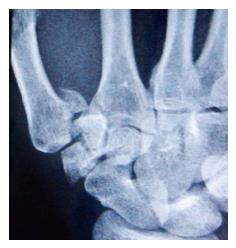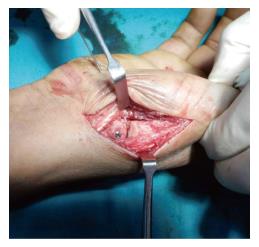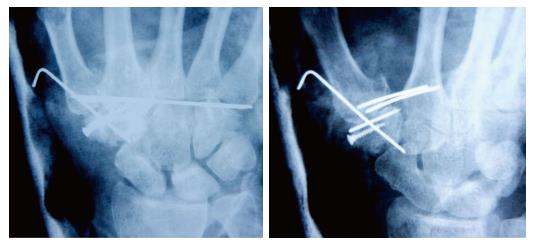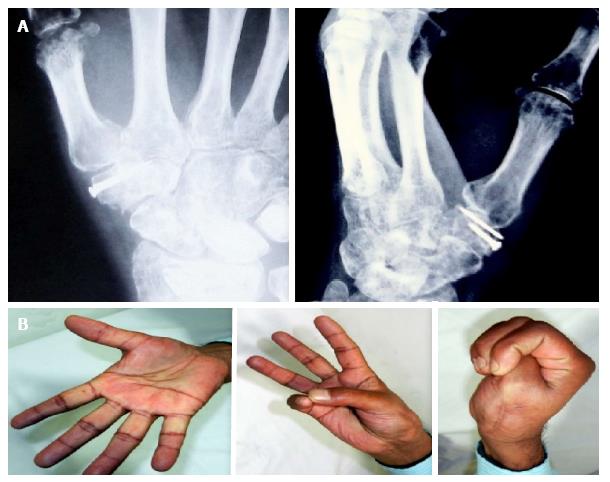Published online Aug 18, 2017. doi: 10.5312/wjo.v8.i8.656
Peer-review started: July 29, 2016
First decision: October 21, 2016
Revised: January 22, 2017
Accepted: February 18, 2017
Article in press: February 20, 2017
Published online: August 18, 2017
Processing time: 382 Days and 11.6 Hours
Association of fracture of trapezium with Bennett’s fracture is very rare and makes reduction and stabilisation more difficult. We are reporting a rare case of Bennett’s fracture with fracture of the trapezium and subluxation of the carpo-metacarpal joint (CMC) joint. The patient was a 47-year-old school teacher who fell from his motorbike on his outstretched right dominant hand. Radiographs and computed tomography showed fracture of the trapezium with subluxation of the CMC joint, associated with Bennett’s fracture. Open reduction and internal fixation was carried out. Trapezium was reduced first and secured with a 2 mm diameter screw. Bennett’s fracture was then reduced and fixed with two per-cutaneously placed Kirchner’s wires. CMC was stabilised with per-cutaneous Kirchner’s wires. Latest follow up at 12 mo showed a healed fracture with good reduction of the CMC joint. Clinically patient had no pain and normal extension, abduction and opposition of the thumb. QuickDASH score was 3.9/100. Thus, fracture of trapezium associated with a Bennett’s fracture is a rare injury and if ignored it may lead to poor results. This injury is more challenging to manage than an isolated Bennett’s fracture as anatomical reduction of the trapezium with reduction of the first CMC is needed. Fracture of the trapezium should be fixed first as this will provide a stable base for reduction of the Bennett’s fracture.
Core tip: Association of fracture of the trapezium with Bennett’s fracture is very rare and makes reduction and stabilisation more difficult. We are reporting a rare case of Bennett’s fracture with fracture of the trapezium and subluxation of the carpo-metacarpal joint (CMC) joint, and describing a technique for successful reduction and stabilisation of these fractures. Trapezium should be reduced first and secured with a 2 mm diameter screw. Bennett’s fracture should then be reduced and fixed with two per-cutaneously placed Kirchner’s wires. CMC should be stabilised with per-cutaneous Kirchner’s wires. This is expected to result in good functional outcomes.
- Citation: Goyal T. Bennett’s fracture associated with fracture of Trapezium - A rare injury of first carpo-metacarpal joint. World J Orthop 2017; 8(8): 656-659
- URL: https://www.wjgnet.com/2218-5836/full/v8/i8/656.htm
- DOI: https://dx.doi.org/10.5312/wjo.v8.i8.656
Bennett’s fracture typically involves an intra-articular fracture of the base of the first metacarpal with dislocation of the carpo-metacarpal joint (CMC). This represents avulsion of the attachment of the volar oblique ligament. Most common mechanism is fall on hand with thumb in abduction or extension. Fractures of the trapezium are rare and accounts for only 3%-5% of carpal fractures[1,2]. Association of fracture of trapezium with a Bennett’s fracture is very rare. Presence of fracture of trapezium makes reduction and stabilisation of the Bennett’s fracture more challenging. High degree of clinical suspicion is necessary as CMC injuries may be a result of indirect force resulting in little swelling[3]. Neglected or untreated injuries may lead to degenerative changes of the CMC joint resulting in pain during grip and pinch.
We are reporting a case of Bennett’s fracture with fracture of the trapezium and disruption of CMC joint. This is an extremely rare injury and only a few cases have been mentioned in literature before[4-7]. Open reduction and internal fixation was carried out and clinical and radiological outcomes were good at 6 mo of follow up.
The patient was a 47-year-old school teacher who fell from his motorbike on his outstretched right hand. He was right hand dominant. Radiographs showed fracture of the trapezium with subluxation of the CMC joint, associated with Bennett’s fracture (Figure 1).
Patient was operated five days after the injury under general anaesthesia. Fracture site was approached using a curved incision beginning at the dorso-radial border of the first metacarpal bone, curving along the junction of the palmer and dorsal skin, to the distal wrist crease. Base of the first metacarpal was recognised which helped in identification of the CMC joint and the trapezium. Trapezium was reduced first and secured with a 0.045-inch Kirchner wire (Figure 2). A 2 mm diameter screw was used to secure the fracture. Bennett’s fracture was reduced and fixed with two per-cutaneously inserted 0.045-inch Kirchner’s wires (Figure 3). The CMC joint was further stabilised with a per-cutaneously inserted 0.045-inch Kirchner’s wire. Limb was put in a thumb spica cast.
Sutures were removed at 10 d followed by removal of Kirchner wires at 3 wk. Cast was continued for a total of 8 wk after the surgery. Range of motion and griping exercises were begun after the cast was removed.
Latest follow up at 12 mo showed no fracture lines, with good reduction of the CMC joint. Clinically patient had no pain and normal extension, abduction and opposition of the thumb (Figure 4). Stress testing of the CMC revealed normal ligaments. QuickDASH score was 3.9/100[8].
Most probable mechanism of Bennett’s fracture with fracture of the trapezium is axial loading of a partially flexed metacarpal bone. Axial loading in a flexed thumb may initially result in a Bennett’s type fracture due to bony avulsion of the anterior oblique ligament. This Bennett’s fragment represents the ulnar-volar part of the base of the metacarpal and has strong capsulo-ligamentous attachments. If the Bennett’s fragment is small and axial loading continues, trapezium will be impacted between the remaining part of metacarpal base and the radial styloid resulting in a vertically split or comminuted fracture of the trapezium. An alternative mechanism of injury could be a hyper-abduction shearing force on the first web-space. This can be seen commonly if a person suffers deceleration injury while holding a handlebar, resulting a commissural shearing force on the first web-space. This may also occur if a person falls on the radial side of the hand with thumb in abduction, so that the first web-space suffers a commissural force.
Stable reduction of the CMC joint and restoring congruity of the articular surface is the goal of treatment[9,10]. Residual subluxation of the joint or intra-articular displacement of more than 4 mm may lead to poor functional outcomes[11].
Fractures of carpal bones of hand, and subluxations of CMCs may be overlooked as soft tissue injuries unless specifically looked for. This will result in poor functional outcomes in long-term follow-up. The type of views imaged or quality of the radiographs may frequently contribute to a missed diagnosis. Appropriate true antero-posterior and lateral radiographs of CMC joint should be insisted. Special views such as Bett view is useful, in which the hand is pronated approximately 20°-30° and the imaging beam is directed obliquely at 15° in a distal to proximal direction, centered over the trapeziometacarpal joint. Computed tomography is a useful imaging modality to study complex fractures of the hand and provides better anatomical details.
Injuries to the CMC joint should be carefully searched for in patients with intra-articular fractures of the trapezium. These may be associated with the Bennett’s fracture, as in this case, or with purely ligamentous injury to the CMC joint. McGuigan and Culp reported 11 patients with intra-articular fractures of the trapezium, four of which were associated with the Bennett’s fracture[4]. Three of these fractures were initially unnoticed. All these patients had good clinical outcomes with open reduction and internal fixation in terms of range of motion, pain and patient satisfaction.
In this case the Bennett’s fracture was associated with the vertically split fracture of the trapezium. These fractures require open reduction and internal fixation in order to control reduction of both these fractures. The fracture of trapezium was fixed first with a K wire and a screw to provide a stable platform for reduction of the Bennett’s fracture. Bennett’s fracture was then fixed with K wires. This gave excellent results at follow up.
Thus, fracture of trapezium associated with a Bennett’s fracture is a rare injury and if ignored it may lead to poor results. Fracture of the trapezium should be fixed first as this will provide a stable base for reduction of the Bennett’s fracture.
This was a rare case of carpal injuries.
Bennett’s fracture dislocation with fracture of Trapezium.
Bennett’s fracture dislocation.
Plain radiographs and computed tomography scan confirmed the diagnosis
The fracture of trapezium was fixed first with a K wire and a screw to provide a stable platform for reduction of the Bennett’s fracture which was then fixed with K wires.
This is a rare injury and if missed may make the reduction and stabilisation of Bennet’s fracture dislocation difficult.
This is generally a good paper.
Manuscript source: Unsolicited manuscript
Specialty type: Orthopedics
Country of origin: India
Peer-review report classification
Grade A (Excellent): 0
Grade B (Very good): 0
Grade C (Good): C, C
Grade D (Fair): D
Grade E (Poor): 0
P- Reviewer: Franklyn MJ, Karalezli N, Martin-Ferrero M S- Editor: Ji FF L- Editor: A E- Editor: Lu YJ
| 1. | Borgeskov S, Christiansen B, Kjaer A, Balslev I. Fractures of the carpal bones. Acta Orthop Scand. 1966;37:276-287. [RCA] [PubMed] [DOI] [Full Text] [Cited by in Crossref: 61] [Cited by in RCA: 49] [Article Influence: 0.8] [Reference Citation Analysis (0)] |
| 2. | Kam ML, Sreedharan S, Teoh LC, Chew WY. Severe isolated trapezoid fracture: a case report. Hand Surg. 2011;16:185-187. [RCA] [PubMed] [DOI] [Full Text] [Cited by in Crossref: 9] [Cited by in RCA: 12] [Article Influence: 0.9] [Reference Citation Analysis (0)] |
| 3. | Ramoutar DN, Katevu C, Titchener AG, Patel A. Trapezium fracture - a common technique to fix a rare injury: a case report. Cases J. 2009;2:8304. [RCA] [PubMed] [DOI] [Full Text] [Cited by in RCA: 1] [Reference Citation Analysis (0)] |
| 4. | McGuigan FX, Culp RW. Surgical treatment of intra-articular fractures of the trapezium. J Hand Surg Am. 2002;27:697-703. [RCA] [PubMed] [DOI] [Full Text] [Cited by in Crossref: 51] [Cited by in RCA: 47] [Article Influence: 2.0] [Reference Citation Analysis (0)] |
| 5. | El Ibrahimi A, Amar F, Chbani B, Daoudi A, Elmrini A, Boutayeb F. Dislocation of the carpometacarpal joint of the thumb associated with trapezium and Bennett’s fractures. Hand (N Y). 2009;4:191-193. [RCA] [PubMed] [DOI] [Full Text] [Cited by in Crossref: 5] [Cited by in RCA: 6] [Article Influence: 0.4] [Reference Citation Analysis (0)] |
| 6. | Garcia-Elias M, Henríquez-Lluch A, Rossignani P, Fernandez de Retana P, Orovio de Elízaga J. Bennett’s fracture combined with fracture of the trapezium. A report of three cases. J Hand Surg Br. 1993;18:523-526. [RCA] [PubMed] [DOI] [Full Text] [Cited by in Crossref: 27] [Cited by in RCA: 22] [Article Influence: 0.7] [Reference Citation Analysis (0)] |
| 7. | Radford PJ, Wilcox DT, Holdsworth BJ. Simultaneous trapezium and Bennett’s fractures. J Hand Surg Am. 1992;17:621-623. [RCA] [PubMed] [DOI] [Full Text] [Cited by in Crossref: 9] [Cited by in RCA: 9] [Article Influence: 0.3] [Reference Citation Analysis (0)] |
| 8. | Beaton DE, Wright JG, Katz JN; Upper Extremity Collaborative Group. Development of the QuickDASH: comparison of three item-reduction approaches. J Bone Joint Surg Am. 2005;87:1038-1046. [RCA] [PubMed] [DOI] [Full Text] [Cited by in Crossref: 440] [Cited by in RCA: 715] [Article Influence: 35.8] [Reference Citation Analysis (0)] |
| 9. | Thurston AJ, Dempsey SM. Bennett’s fracture: a medium to long-term review. Aust N Z J Surg. 1993;63:120-123. [RCA] [PubMed] [DOI] [Full Text] [Cited by in Crossref: 27] [Cited by in RCA: 21] [Article Influence: 0.7] [Reference Citation Analysis (0)] |
| 10. | Timmenga EJ, Blokhuis TJ, Maas M, Raaijmakers EL. Long-term evaluation of Bennett’s fracture. A comparison between open and closed reduction. J Hand Surg Br. 1994;19:373-377. [RCA] [PubMed] [DOI] [Full Text] [Cited by in Crossref: 53] [Cited by in RCA: 38] [Article Influence: 1.2] [Reference Citation Analysis (0)] |
| 11. | Walker JL, Greene TL, Lunseth PA. Fractures of the body of the trapezium. J Orthop Trauma. 1988;2:22-28. [RCA] [PubMed] [DOI] [Full Text] [Cited by in Crossref: 50] [Cited by in RCA: 50] [Article Influence: 1.4] [Reference Citation Analysis (0)] |












